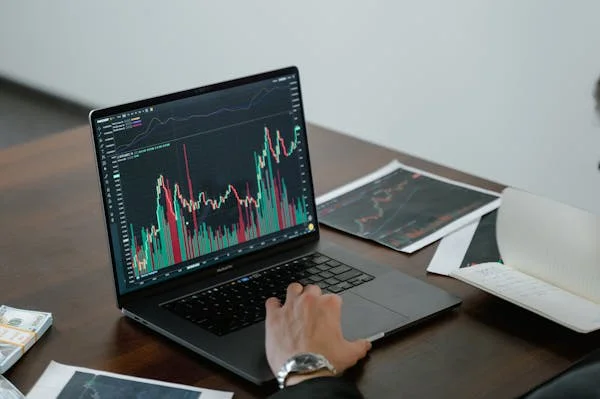Introduction
Stratos Investment Buffered ETFs are designed to provide investors with exposure to market growth while offering downside protection through a predefined buffer. These ETFs use options strategies to limit losses within a certain range, allowing investors to participate in market gains up to a specific cap. The combination of downside protection and upside potential makes these funds particularly attractive during volatile market conditions.
What is an ETF?
An Exchange-Traded Fund (ETF) is a type of investment fund that is traded on stock exchanges, much like stocks. ETFs hold a collection of assets, such as stocks, bonds, or commodities, and allow investors to gain diversified exposure to a specific market, sector, or asset class. ETFs are known for their liquidity, low fees, and ease of trading. However, traditional ETFs do not provide built-in protection against market downturns.
Buffered ETFs: An Innovation in Risk Management
Buffered ETFs are a relatively innovation in the world of ETFs. They provide an additional layer of protection by utilizing financial instruments such as options to create a “buffer” against losses. This buffer typically covers the first 10% to 20% of losses, meaning that investors are shielded from small to moderate declines in the market. However, the trade-off for this protection is that the upside potential is often capped, limiting the amount of profit an investor can earn during a market rally.
Stratos Investment Buffered ETFs follow this model, allowing investors to enjoy the benefits of both protection and growth. These funds are designed to appeal to investors who want exposure to the stock market but are concerned about significant losses during periods of volatility.
How Stratos Investment Buffered ETFs Work
Stratos Investment Buffered ETFs use options strategies to create a risk buffer and cap potential gains. These strategies involve purchasing put options, which provide downside protection, and selling call options, which limit the upside potential. The structure of these funds is designed to balance the trade-off between risk mitigation and growth opportunities.
Key Components of Buffered ETFs
- Buffer: The buffer is the amount of market decline that the ETF can absorb without affecting the investor’s principal. For example, if an ETF has a 10% buffer, the fund will absorb the first 10% of losses. If the market declines by 15%, the investor will only experience a 5% loss.
- Cap: The cap is the maximum amount of return an investor can earn from the ETF during the outcome period. This limit is set in advance, and once the cap is reached, the investor cannot benefit from further market gains. For example, if the cap is set at 15% and the market rises by 20%, the investor will only earn a 15% return.
- Outcome Period: Buffered ETFs have a fixed outcome period, which is typically one to two years. During this period, the terms of the buffer and cap remain in effect. At the end of the outcome period, the ETF is either reset or liquidated and the terms are adjusted based on current market conditions.
How the Options Work
Buffered ETFs use options to create the buffer and cap. Specifically, they use put options to protect against downside risk and call options to limit upside potential.
- Put Options: These financial contracts give the ETF the right to sell a specific asset at a predetermined price. By purchasing put options, the ETF gains the ability to offset losses if the market declines. The buffer is created by the amount of protection provided by these put options.
- Call Options: Call options give the ETF the right to buy an asset at a predetermined price. By selling call options, the ETF limits its ability to profit from market gains. The cap is created by the amount of profit the ETF can earn from these call options.
Through these options strategies, the ETF provides a predictable range of returns based on the market’s performance during the outcome period.
Benefits of Stratos Investment Buffered ETFs
Stratos Investment Buffered ETFs offer a range of benefits to investors looking for a balanced approach to risk and reward. Let’s take a closer look at the key advantages of these funds.
1. Downside Protection
One of the most significant advantages of Stratos Investment Buffered ETFs is the downside protection they offer. The buffer provides a cushion against market declines, which can be especially valuable during periods of market volatility. This protection can help preserve your capital and reduce the emotional stress of market downturns.
For example, if the broader market experiences a 10% decline and the ETF has a 10% buffer, the investor will not experience any losses. However, if the market declines by 15%, the investor will only lose 5%, thanks to the buffer.
2. Exposure to Market Growth
Buffered ETFs allow investors to participate in market growth, even though the upside is capped. While there is a limit on the returns an investor can earn, the ability to capture some of the market’s upside potential is an attractive feature. For investors who are willing to accept a capped return in exchange for downside protection, Stratos Investment Buffered ETFs offer a balanced approach.
For instance, if the market rises by 12% and the ETF has a cap of 10%, the investor will earn a 10% return. This growth, combined with the downside protection, can provide a solid return on investment.
3. Tax Efficiency
Buffered ETFs are generally more tax-efficient than traditional mutual funds. This is because ETFs are structured in a way that minimizes taxable events. Unlike mutual funds, which can distribute capital gains to investors, ETFs typically do not require distributions unless the investor sells their shares. This can help investors avoid taxable events during the holding period and can be beneficial for long-term investors.
4. Lower Fees Compared to Active Management
Buffered ETFs typically have lower fees than actively managed funds. This is because they are passively managed, meaning the fund does not require constant monitoring and decision-making by fund managers. The use of options strategies, while adding some complexity, does not result in the same level of cost as active management.
5. Flexibility and Liquidity
Buffered ETFs are traded on the stock exchange, just like other ETFs, which means they offer liquidity and flexibility. Investors can buy or sell shares of these ETFs throughout the trading day, making them more liquid than mutual funds. This flexibility allows investors to respond quickly to changing market conditions.
Potential Drawbacks of Stratos Investment Buffered ETFs
While Stratos Investment Buffered ETFs offer several benefits, they also have some potential drawbacks. It’s important to consider these factors before deciding if they are right for your investment strategy.
1. Limited Upside Potential
The main drawback of Buffered ETFs is the capped upside potential. While the buffer offers downside protection, the fund’s return is limited by the cap. This means that during strong market rallies, the ETF will not capture the full upside potential, which can be frustrating for investors who want to benefit from significant market gains.
For example, if the market rises by 25%, and the ETF has a cap of 10%, the investor will only earn a 10% return. In contrast, traditional ETFs would allow investors to fully capture the 25% return.
2. Complex Structure
Buffered ETFs are more complex than traditional ETFs, and understanding how they work requires a basic knowledge of options trading. While the concept of a buffer and cap is relatively straightforward, the actual mechanics of the options strategies can be difficult to grasp for some investors. This complexity can be a barrier for those who prefer simple, easy-to-understand investments.
3. Holding Period Requirements
Buffered ETFs typically have a fixed outcome period, such as one or two years. During this period, the buffer and cap terms are in effect. If an investor needs to sell their ETF shares before the outcome period ends, they may not receive the full benefits of the buffer or cap. In addition, early sales may lead to a loss of some of the protection or growth potential.
4. Cost of Options
The options strategies used to create the buffer and cap come at a cost. While Buffered ETFs generally have lower fees than actively managed funds, the cost of purchasing and selling options can still reduce the fund’s overall performance. The use of options adds complexity and cost, which may detract from the potential returns, especially if the market moves significantly in either direction.
How to Invest in Stratos Investment Buffered ETFs
Investing in Stratos Investment Buffered ETFs is relatively simple, but it’s important to understand the features and risks associated with these funds before getting started. Here are the steps to help you invest in these unique ETFs.
1. Do Your Research
Before investing in Stratos Investment Buffered ETFs, it’s important to research the different funds available. Each fund has different buffer and cap levels, and the terms of the ETF will vary based on market conditions. Review the prospectus for each ETF to understand its strategy, underlying index, and outcome period.
2. Evaluate Your Risk Tolerance
Buffered ETFs are designed to appeal to conservative investors who want protection against market declines but are still willing to accept capped growth potential. If you are comfortable with the trade-off between downside protection and limited upside, then these ETFs may be a good fit for your portfolio.
3. Choose the Right Fund
Once you’ve determined your risk tolerance and financial goals, choose a Stratos Investment Buffered ETF that aligns with your needs. Consider factors such as the buffer level, cap level, outcome period, and underlying index.
4. Open a Brokerage Account
To invest in Stratos Investment Buffered ETFs, you will need a brokerage account. These ETFs can be purchased through most brokerage platforms, including those offered by traditional brokers and online discount brokers.
5. Monitor Performance
After investing in Stratos Investment Buffered ETFs, it’s important to monitor the performance of the fund and track how it is performing relative to the market. Keep an eye on market conditions, as these ETFs are designed to work best during periods of market volatility.
Conclusion
Stratos Investment Buffered ETFs offer an innovative way for investors to manage risk while still participating in market growth. By combining downside protection with upside potential, these funds provide a balanced approach to investing. However, they are not without their drawbacks, including limited upside and a complex structure. Understanding how these ETFs work and evaluating your own investment goals and risk tolerance are key to determining whether they are a suitable addition to your portfolio.
As always, consider consulting with a financial advisor to help determine the best investment strategy for your unique financial situation. By doing your research and carefully considering the benefits and drawbacks, you can make an informed decision about whether Stratos Investment Buffered ETFs are right for you.
Frequently Asked Questions (FAQs)
What is a Stratos Investment Buffered ETF?
Stratos Investment Buffered ETFs offer downside protection with limited upside. They use options strategies to shield investors from market losses while capping returns.
How does the buffer work in these ETFs?
The buffer absorbs a percentage of losses, typically 10-20%. It helps protect against market declines up to that level, limiting investor exposure to losses.
What are the risks of investing in Buffered ETFs?
The key risk is the cap on potential gains. Investors miss out on returns if the market grows beyond the ETF’s pre-defined limit.
How do I invest in Stratos Investment Buffered ETFs?
Invest in these ETFs through a brokerage account. They can be bought and sold like any other ETF on the stock exchange.
Are Stratos Investment Buffered ETFs tax-efficient?
Yes, these ETFs are tax-efficient because they avoid capital gains distributions, reducing taxable events for investors.






